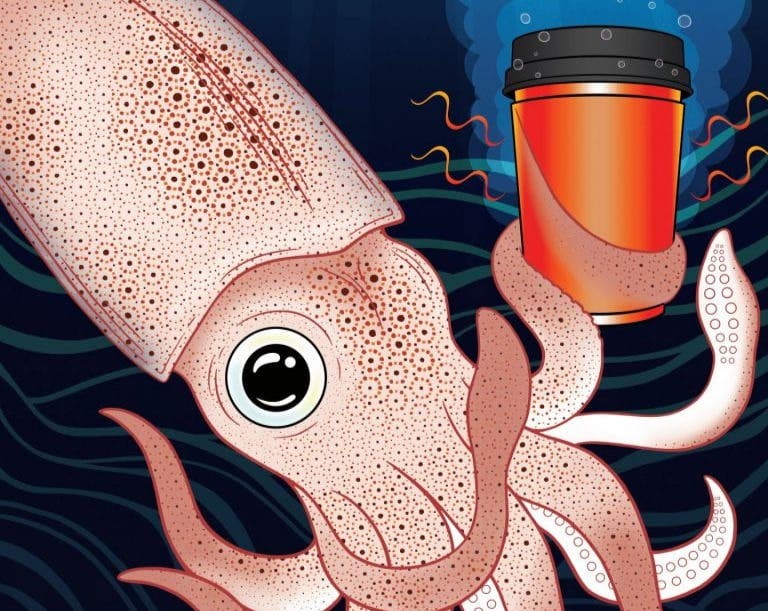Squid skin-inspired cup cozy will keep your hands cool and your coffee hot
Researchers have invented a squid-skin inspired material that can wrap around a coffee cup to shield sensitive fingers from heat.

[Mar 30, 2022: Brian Bell, University of California - Irvine]
Researchers in the Department of Chemical and Biomolecular Engineering at the University of California, Irvine have invented a squid-skin inspired material that can wrap around a coffee cup to shield sensitive fingers from heat. They have also created a method for economically mass producing the adaptive fabric, making possible a wide range of uses. (CREDIT: Melissa Sung)
In the future, you may have a squid to thank for your coffee staying hot on a cold day. Drawing inspiration from cephalopod skin, engineers at the University of California, Irvine invented an adaptive composite material that can insulate beverage cups, restaurant to-go bags, parcel boxes and even shipping containers.
The innovation is an infrared-reflecting metallized polymer film developed in the laboratory of Alon Gorodetsky, UCI associate professor of chemical and biomolecular engineering. In a paper published today in Nature Sustainability, Gorodetsky and his team members describe a large-area composite material that regulates heat by means of reconfigurable metal structures that can reversibly separate from one another and come back together under different strain levels.
“The metal islands in our composite material are next to one another when the material is relaxed and become separated when the material is stretched, allowing for control of the reflection and transmission of infrared light or heat dissipation,” said Gorodetsky. “The mechanism is analogous to chromatophore expansion and contraction in a squid’s skin, which alters the reflection and transmission of visible light.”
Chromatophore size changes help squids communicate and camouflage their bodies to evade predators and hide from prey. Gorodetsky said by mimicking this approach, his team has enabled “tunable thermoregulation” in their material, which can lead to improved energy efficiency and protect sensitive fingers from hot surfaces.
Related Stories
A key breakthrough of this project was the UCI researchers’ development of a cost-effective production method of their composite material at application-relevant quantities. The copper and rubber raw materials start at about a dime per square meter with the costs reduced further by economies of scale, according to the paper. The team’s fabrication technique involves depositing a copper film onto a reusable substrate such as aluminum foil and then spraying multiple polymer layers onto the copper film, all of which can be done in nearly any batch size imaginable.
“The combined manufacturing strategy that we have now perfected in our lab is a real game changer,” said Gorodetsky. “We have been working with cephalopod-inspired adaptive materials and systems for years but previously have only been able to fabricate them over relatively small areas. Now there is finally a path to making this stuff roll-by-roll in a factory.”
The developed strategy and economies of scale should make it possible for the composite material to be used in a wide range of applications, from the coffee cup cozy up to tents, or in any container in which tunable temperature regulation is desired.
The invention will go easy on the environment due its environmental sustainability, said lead author Mohsin Badshah, a former UCI postdoctoral scholar in chemical and biomolecular engineering. “The composite material can be recycled in bulk by removing the copper with vinegar and using established commercial methods to repurpose the remaining stretchable polymer,” he said.
The team conducted universally relatable coffee cup testing in their laboratory on the UCI campus, where they proved they could control the cooling of the coffee. They were able to accurately and theoretically predict and then experimentally confirm the changes in temperature for the beverage-filled cups. The was also able to achieve a 20-fold modulation of infrared radiation transmittance and a 30-fold regulation of thermal fluxes under standardized testing conditions. The stable material even worked well for high levels of mechanical deformation and after repeated mechanical cycling.
“There is an enormous array of applications for this material,” said Gorodetsky. “Think of all the perishable goods that have been delivered to people’s homes during the pandemic. Any package that Amazon or another company sends that needs to be temperature-controlled can use a lining made from our squid-inspired adaptive composite material. Now that we can make large sheets of it at a time, we have something that can benefit many aspects of our lives.”
Joining Gorodetsky and Badshah on this project were Erica Leung, who recently graduated UCI with a Ph.D. in chemical and biomolecular engineering, and Aleksandra Strzelecka and Panyiming Liu, who are current UCI graduate students.
The research was funded by the Defense Advanced Research Projects Agency, the Advanced Research Projects Agency – Energy and the Air Force Office of Scientific Research. A provisional patent for the technology and manufacturing process has been applied for.
Note: Materials provided above by University of California - Irvine. Content may be edited for style and length.
Like these kind of feel good stories? Get the Brighter Side of News' newsletter.
Tags: #New_Discoveries, #Coffee, #Heat, #Squid, #Skin, #Insulation, #Research, #Science, #The_Brighter_Side_of_News
Joseph Shavit
Head Science News Writer | Communicating Innovation & Discovery
Based in Los Angeles, Joseph Shavit is an accomplished science journalist, head science news writer and co-founder at The Brighter Side of News, where he translates cutting-edge discoveries into compelling stories for a broad audience. With a strong background spanning science, business, product management, media leadership, and entrepreneurship, Joseph brings a unique perspective to science communication. His expertise allows him to uncover the intersection of technological advancements and market potential, shedding light on how groundbreaking research evolves into transformative products and industries.



